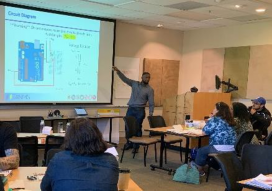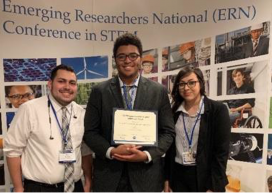TANMS ERC Establishes Highly-Integrated Engineering Pathways for Teachers and Students
The Center for Translational Applications of Nanoscale Multiferroic Systems (TANMS) at the University of California, Los Angeles (UCLA) has developed a highly integrated approach to course development focused on its innovations in electromagnetic nanomotors and mechanical systems. The novel method, which combines new science learning with research experiences and mentoring projects, is successfully introducing TANMS ideas to thousands of high school students across California under the TANMS High School Science Initiative (HSSI); an associated Math, Engineering, and Science Achievement (MESA) Schools course; and its National Science Foundation (NSF)-funded education programs.
The advancement of TANMS’ “cradle-to-career” vision contributes to the development of a more diverse and innovative engineering workforce. By engaging both new and established teachers in jointly creating engineering pathways for students at multiple learning levels, the TANMS Engineering Research Center (ERC) facilitates professional teacher development while also writing and introducing new STEM course materials. The ERC leverages its NSF Research Experiences for Teachers (RET) program towards project-based curriculum development in order to promote and simultaneously achieve science engagement and learning. This significantly speeds the spread of key concepts and discoveries from TANMS advanced research while also gaining hands-on participation from students and educators at various education levels, leading to greater STEM persistence and interest in TANMS research experience opportunities. The new method also includes a Research Experience and Mentoring (REM) program that pairs TANMS undergraduate students with high school students exposed to the electromagnetic nanomotors curriculum as “near-peer” mentors, allowing participants at both levels to gain greater STEM efficacy through their own educational growth. As a result of this approach, REM students tend to demonstrate ongoing TANMS interest and experience by going on to pursue Research Experiences for Undergraduates (REU) programs or by applying themselves towards four-year Engineering degree programs. Finally, this method achieves important gains in authentic diversity and inclusivity; the TANMS/MESA Course is expected to have an initial statewide reach of approximately 350 MESA schools serving low-income, underrepresented minority (URM) students.
As part of its HSSI program, TANMS developed a learning module focused on electromagnetic nanomotors with its RET participants. The module was piloted in high school classes at Lawndale High School in California during the 2016-2017 school year. In 2018 and 2019, the HSSI went on to implement the Electromagnetic Nanomotors Module at 21 school locations in 9 school district, reaching a total of 2,500 students.
TANMS also collaboratively developed a course for the MESA Schools program—a pre-college program designed to serve educationally disadvantaged students by preparing them for careers in math, science, engineering, computer science, and technology. Graduate students participating in the TANMS ERC developed the initial units for the year-long MESA course. During the early development in 2018 and 2019, Teacher Institute participants provided feedback; and MESA course approval was obtained from the University of California Office of President (UCOP) in 2019. The 2020 Summer RET cohort finalized the MESA course and planned to pilot it in classrooms during the 2020-2021 school year.
The TANMS ERC received three supplemental NSF grants in 2018, 2019, and 2020 for its associated REM Program, with grant funding of $100,000 received annually, for a total $300,000 in STEM program investment to date. These funds were used to expand TANMS’ partnership efforts in 2019 with relationships at the El Camino College MESA/STEM Center and UCLA’s eTransfer Center as examples. During this time, TANMS also established its tiered mentoring model, which pairs college and high school students together for more supportive experience-based learning. Three of these TANMS REM participants—Nery Arevalos, Naim Wright, and Connie Valles—attended the 2019 Emerging Researchers National Conference in Washington, DC. Their research presentation on “Growth and Characterization of Designer Magnetostrictive Thin Films for High Frequency Applications”—undertaken in the laboratory of TANMS Professor Jane P. Chang with guidance from graduate student mentor and TANMS Fellow, Adrian Acosta—garnered an award for the Conference’s REM Poster Session.



